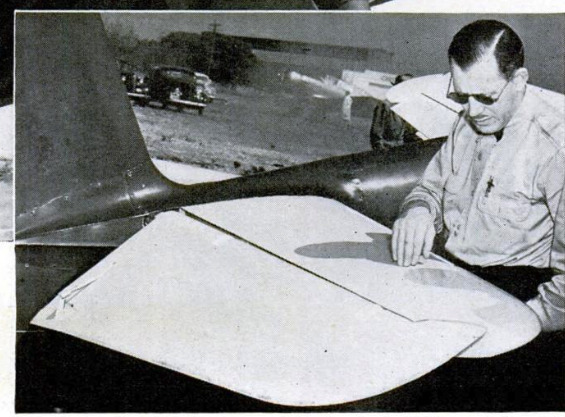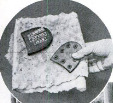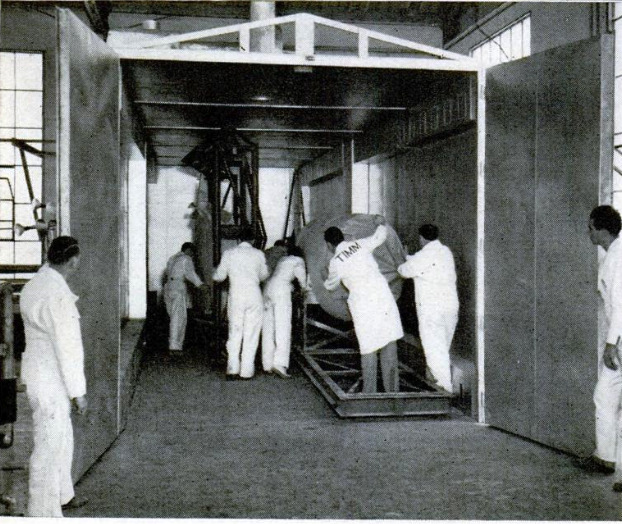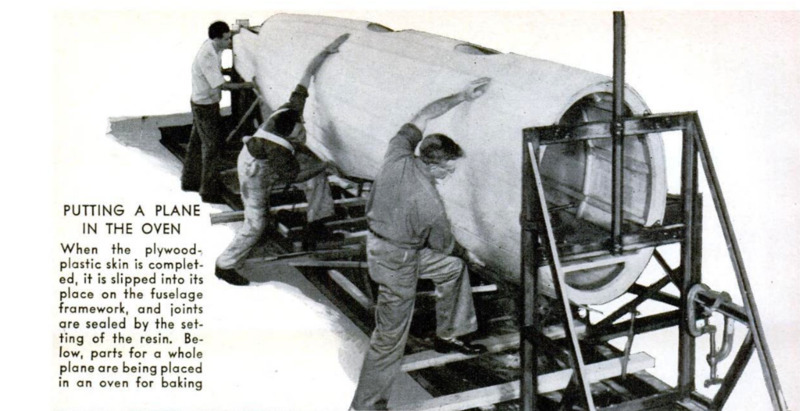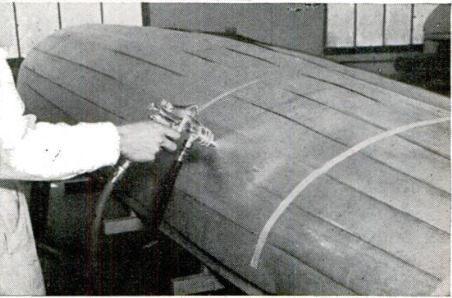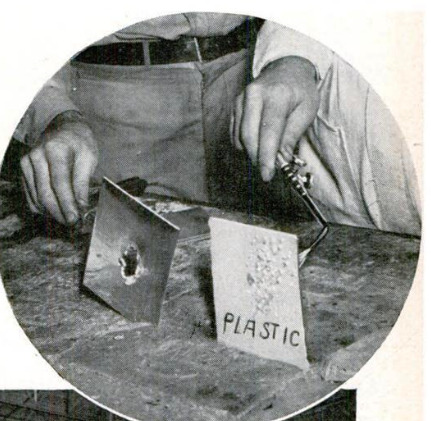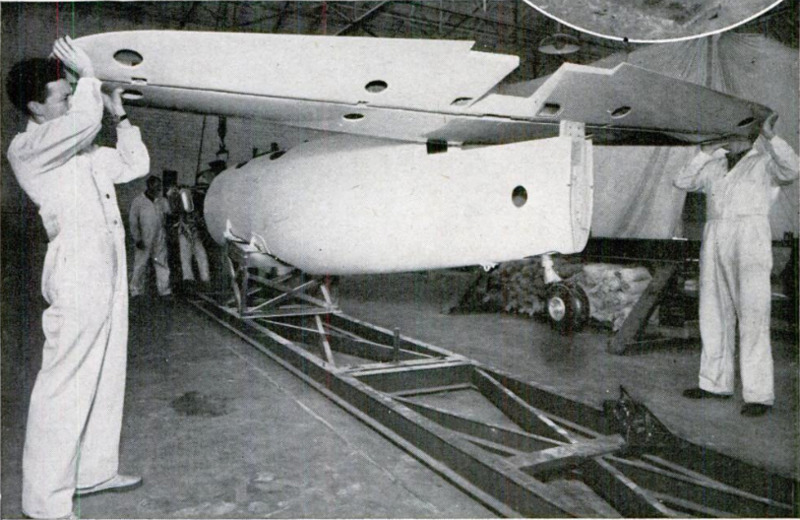-
Title (Dublin Core)
-
Plastic airplanes revolutionize aircraft design
-
Article Title and/or Image Caption (Dublin Core)
-
Plastic airplanes revolutionize aircraft design
-
extracted text (Extract Text)
-
PHENOMENALLY strong, unbelievably
smooth, resistant to time and weather,
impervious to water, fireproof, cor-
rosionproof, and easy to fabricate—these
are the outstanding claims made for new
plastic airplanes being built at Van Nuys,
Calif., by the Timm Aircraft Corp. Experts
believe that the development may revolu-
tionize the airplane industry and become one
of the most potent factors in our nation-
al defense program.
For the new air-
plane, actually made
of plywood impreg-
nated and bonded with
a phenol resin plastic,
can be molded to
shape in a press. Parts of planes can be
stamped out in only a fraction of the time
that would be required to construct them of
riveted or welded metal. And in a world
racked by a conflict that has demonstrated
the primary importance of airplanes as
weapons of war, the rapid construction of
military airplanes becomes a matter of vital
significance, almost a matter of life or death.
America can build motors faster than any
other country in the
world—but you can't
fly a motor by itself.
Right there you come
up against the bottle-
neck of the airplane in-
dustry, the problem of
constructing metal
wings and fuselage.
Moreover, metal is ex-
pensive, heavy to trans-
port, bulky to store.
Planes of plastic and plywood would solve all these
problems at one crack. They could be turned out
in numbers that would stagger the imagination. The
first such craft, which flew the other day near Los
Angeles may, like the first locust, be the apparently
insignificant forerunner of a great swarm.
But that's getting a little ahead of the story. Let's
take a look behind the scenes and see just how
plywood or “plastic” planes are built—and just
what their military and commercial importance
is likely to be.
As things stand now, two plants in the United
States are producing such planes on an experimental
basis. No military aircraft have yet been completed,
but several experimental models are almost ready
for testing. Nothing approximating mass production
has yet been attempted. The first ship to be produced
by practical mass-production methods was
the one flown near Los Angeles. It is a two-
seater, open-cockpit, training model powered
by a 160-horsepower motor and capable of
a speed of 140 miles an hour.
There is nothing in the methods by which
that plane was built, however, which cannot
be applied to high-speed streamline produc-
tion. Briefly, the method of construction
consists of a half dozen steps.
First a half shell of each essential section
of the plane is built up on a jig. Strips of
spruce, which are the full length of the
section being formed, a few inches wide, and
one twenty-fourth of
an inch thick, are
arranged to form three
plies, or layers, thes
grain of the center ply
being at right angles to
that of the top and bot-
tom plies, as in com-
mon plywood.
Next the plies are
sprayed with a phenol
resin plastic compound
whose composition is
similar to bakelite.
‘This takes the place of
the glue used in ordinary
plywood. But instead
of being applied only
to the surface of the
wood, as in the case of glue, the plastic is
forced into the cells of the wood.
After the plastic binder sets, the rough
shell is placed in a mold which is the exact
size and contour desired. Pressure is then
applied, forming the shell to the precise
shape, and at the same time fusing the
plastic compound with the wood, so as to
form a completely new substance. The
method of forming which seems to have the
greatest practical advantage uses cold
pressure, thereby eliminating the problem
of constructing complicated heated presses.
When a plywood-plastic shell comes from
the press, it is smooth and almost metallic
in appearance. It is then placed on a huge
Jig which has the form of a large section of
the plane, such as the fuselage or wings.
The plywood-plastic “skins” which are to
cover each section of the plane are then
arranged in place, as if they were die-
stamped sheets of metal. But instead of
being riveted together, the joints are simply
sprayed with additional plastic. When this
sets, the joint is as strong as the material.
T= plane has now been formed in several
large sections. These sections include
the entire fuselage, the wings, and the tail
surfaces. These sections are given a final
spray of plastic, then placed in a gigantic
oven where they are baked at temperatures
varying from 180 to 240 degrees. This heat
finally sets the separate plywood-plastic
“skins” into a single mass without seams.
To complete the plane, it is only necessary
to attach the wings to the fuselage with
simple couplings, to assemble the tail sur-
faces, and to mount the motor in place with
swiftly completed attachments, Interior
construction, including controls and seats,
has already been completed while the fuse-
lage was on the jig. This is a simple opera-
tion, as the installation is done when only
one of the two shells forming the fuselage
is in place.
The plane is now ready to fly. It has been
built with only a fraction of the labor
necessary for metal construction. The ma-
terial is far cheaper, much more available.
It is twenty percent lighter than metal, and
is far more resistant to fire. Elimination of
all external roughness, such as rivet heads
and joints, gives increased speed poten-
tialities of up to twenty-five percent.
But what of the other side of the picture?
Are there any outstanding faults to this
method of construction? Are there “bugs”
which would interfere with its use for
military airplanes?
There is one major defect of the plastic
plane, but apparently it would only become
serious in certain types of operations. It is
the fact that plywood-plastic planes are
difficult to repair.
As one engineer said: “It's like trying to
mend a hole in a glass bottle.
Engineers are now working on this prob-
lem. In any case, this objection is not so
serious as far as military airplanes go, for
warplanes are usually either only slightly
damaged, or are a total loss.
Another problem of plywood-plastic con-
struction of military planes is that it re-
quires rigid standardization. The designs of
planes must be completely standardized be-
fore molds can be constructed. On the other
hand, molds must be constructed in large
numbers long before production of a par-
ticular model can begin. However, as the
present European war proves, standardiza-
tion of military aircraft is a distinct ad-
vantage.
There is one other test the plywood-
plastic plane must pass—that of actual
experience. This type of construction has
passed every laboratory test that engineers
could devise. Now it must pass the final
acid test of thousands of hours of flight,
flight in storm and calm, under every con-
ceivable condition.
If it passec that test, America may have
airplane production potentialities which will
make the present-day skies, plane-filled
though they are, seem empty.
-
Contributor (Dublin Core)
-
Re DeWitt Miller (article writer)
-
Language (Dublin Core)
-
eng
-
Date Issued (Dublin Core)
-
1940-08
-
pages (Bibliographic Ontology)
-
66-69, 214
-
Rights (Dublin Core)
-
Public domain
-
Archived by (Dublin Core)
-
Sami Akbiyik
-
Marco Bortolami (editor)
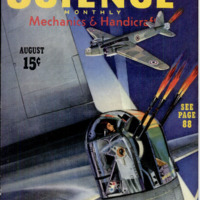 Popular Science Monthly, v. 137, n. 2, 1940
Popular Science Monthly, v. 137, n. 2, 1940


